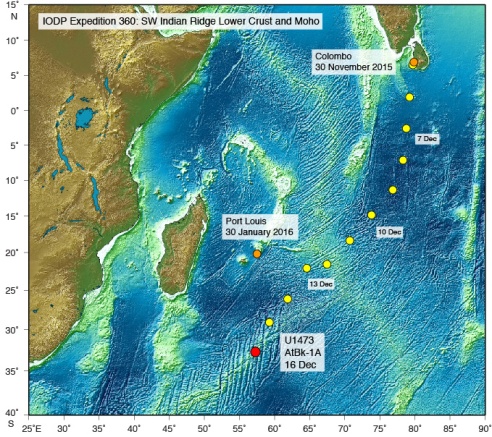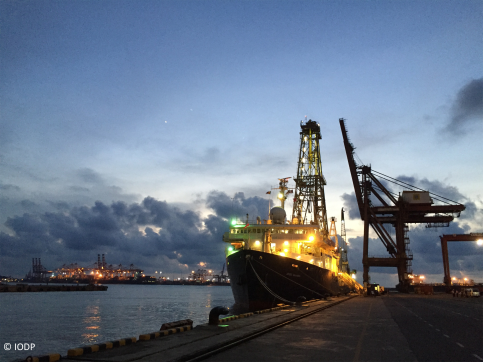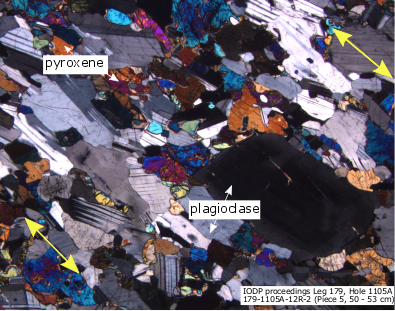Today, we are getting an impression of how daily life is on board of a scientific drilling vessel. At the moment Carlotta is on board the Joides Resolution, one of the scientific drilling ships of the International Ocean Discovery Program (IODP). She is part of the Expedition 360 Southwest Indian Ridge with its goal to drill into rocks of the lowermost oceanic crust and the crust-mantle transition zone (see blogpost about the oceanic crust). The SW Indian Ridge is a very slow spreading ridge (that means that the oceanic plates diverge about 8 mm/yr), located south-east of Madagascar (see image 1). The expedition started on 30th November, leaving Colombo and will end 30th of January once Port Louis will be reached. You see, this is quite a long time she is spending at sea!
I asked Carlotta a few question about how it is to be part of such an adventure and how it feels to work on a ship that moves all the time with the same group of people for 2 months!

Carlotta, how are you? How is it to live and work on board of a moving ship?
I am doing great here on board. Life is totally “unstable” in the middle of the Ocean. During the transit the weather was relatively good but still, sometimes the waves even reached 10 m height.
How many people are on board?
We are a total of 122 people sailing on Exp 360. There are 66 crew members as well as 22 IODP technical staff members, including Captain Terry Skinner and Operations Superintendent Stephen Midgley. The Science party is composed of 34 members with different expertise and experience, coordinated by our Expedition Manager Peter Blum and the two Co-Chiefs, Henry Dick and Chris MacLeod.

How is the atmosphere on board?
At the moment the atmosphere is relatively calm, but we are still on transit (this means that the drill site has not been reached). Scientists have the opportunity to discuss their projects, research goals and possible collaborations. In the first days everybody was really excited about being at sea and ready to start their work. This first part of the Expedition is the “early production phase”, where the excitement is great and accompanied by some chaos. Later on at “mid-cruise” scientists reach the peak of their work performance. It will also be the phase when the drilling is going on for 24h/7days. In the end there will be the really stressful period, the “last production and wrapping up phase”. I am saying stressful because exhaustion will take over and everybody will feel the pressure related to the final report. This final scientific report will summarize all petrological and structural observations of the collected cores, their physical properties and their geochemical- paleo-magnetic signature along with some microbiological observations.
Can you tell us more about your work? What is your task? How is the work organized?
I am a member of the structural geology team. Our task is to describe any structure we see in the core. This can be anything from magmatic deformation to crystal- and brittle deformation or veins. My task is to measure and describe the magmatic fabric. The magmatic fabric is an alignment of minerals in the rock (see image 3). It is formed when the magma already contains a lot of crystallized minerals (the magma is then a so called crystal mush) and these minerals start to be aligned in a certain orientation (for more information see blogpost about the formation of minerals). For example, they might align themselves in the flow direction of the crystal mush. In all the cores we get I`m measuring the orientation of this fabric and describing it in more details. Beside all the petrological and geochemical information of the rocks, the structural observations will help to solve fundamental questions of how the lower oceanic crust is formed.
The scientific crew works 24 h/7 days! So there is always somebody at work. I`m working on the night shift, so we start our work at 2 am and finish at 2 pm. It is a total of twelve hours of work but if there is urgent work which has to be done we might even work thirteen hours.

What does the lab that you work in look like? How many different labs are there?
The lab itself is relatively big, considering that we are on a boat. However, it is located in the upper part of the ship and it was shaking during the transit. This was an area that several people avoided until we were on site. In our lab we have three different big tables where cores are displayed and several computer screens are standing to record our descriptions. In the same room there is also the facility to measure the magnetic signature. Next to our lab there is a room with several microscopes only dedicated to thin section descriptions. There is also an SEM (scanning electron microscope) on board to observe the samples at higher magnification compared to the optical microscope and to do some chemical measurements, how cool is this!
On the same floor three experts work on physical properties of the rocks from the drill cores. They rotate in different shifts as well. On the lower floor there are two other labs. One is dedicated to geochemical analyses, whereas in the other two microbiologists assess the presence of life in these rocks.
Are you always working with the same people?
Yes, but very often we meet with other groups to compare results. Once per day we all meet in the big conference room to summarize the daily achievements and to share our observations.
What are you doing beside of working?
If it is not too hot (so when it is not sunny) I go outside and read a book. Otherwise, I go to the gym or hangout with my colleagues.
How is the food?
The food is great! The Catering team is composed of very good cooks! They try to make different food every day. Sunday is the day where we have BBQ.
Where is your favourite place/spot on the ship?
My favourite place on board is outside on top of the boat. We are only allowed to be in the front part. I love being there to get some fresh air and admire the awesome view of the infinite Ocean!
Read more about the expedition on the International Ocean Discovery Program (IODP) and follow their blog!